
The deepwater stingray or giant stingaree is a species of stingray and the sole member of the family Plesiobatidae. It is widely distributed in the Indo-Pacific, typically over fine sediments on the upper continental slope at depths of 275–680 m (900–2,230 ft). This species reaches 2.7 m (8.9 ft) in length and 1.5 m (4.9 ft) in width. It has an oval pectoral fin disc with a long, flexible, broad-angled snout. Most of the entire latter half of its tail supports a distinctively long, slender, leaf-shaped caudal fin. Its coloration is dark above and white below, and its skin is almost completely covered by tiny dermal denticles.
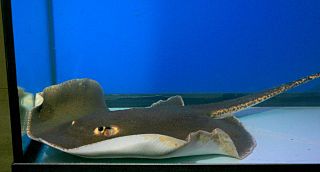
The roughback whipray is a rare species of freshwater stingray in the family Dasyatidae, found over sandy bottoms in the Mae Klong and Chao Phraya Rivers of Thailand. Growing no more than 29 cm (11 in) across, this small ray has an oval pectoral fin disc and a whip-like tail without fin folds. It closely resembles the white-edge freshwater whipray in appearance, but can be distinguished by its coloration: light gray to dark orange-brown above and white below with a dark band along the lateral margins. Another identifying feature is a "pearl organ" at the center of the back, found in individuals of all ages. All of the original specimens of the roughback whipray were found with extensive wounds to the fins and tail. The International Union for Conservation of Nature (IUCN) has assessed this species as Endangered, citing the extensive habitat degradation and heavy fishing pressure within its limited range.
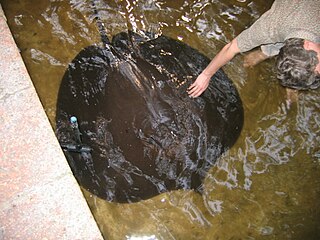
The giant freshwater stingray is a species of stingray in the family Dasyatidae. It is found in large rivers and estuaries in Southeast Asia and Borneo, though historically it may have been more widely distributed in South and Southeast Asia. The widest freshwater fish and the largest stingray in the world, this species grows up to 2.2 m (7.2 ft) across and can reach up to 300 kg (660 lb) in weight. It has a relatively thin, oval pectoral fin disc that is widest anteriorly, and a sharply pointed snout with a protruding tip. Its tail is thin and whip-like, and lacks fin folds. This species is uniformly grayish brown above and white below; the underside of the pectoral and pelvic fins bear distinctive wide, dark bands on their posterior margins.
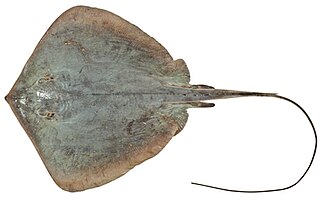
The estuary stingray, also called the estuary stingaree or brown stingray, is a species of stingray in the family Dasyatidae. Endemic to eastern Australia, it typically inhabits shallow, mangrove-lined tidal rivers, estuaries, and bays in southern Queensland and New South Wales. This yellow-brown to olive ray grows to at least 93 cm (37 in) across. It has a diamond-shaped pectoral fin disc and a mostly smooth, whip-like tail bearing both dorsal and ventral fin folds. It can additionally be identified by its long, narrow nostrils and the row of thorns along the midline of its back.
The Niger stingray or smooth freshwater stingray is a species of stingray in the family Dasyatidae, native to rivers in Nigeria and Cameroon. Attaining a width of 40 cm (16 in), this species can be distinguished by its thin, almost circular pectoral fin disk, slightly projecting snout tip, and mostly smooth skin with small or absent dermal denticles. The Niger stingray feeds on aquatic insect larvae and is ovoviviparous. The long stinging spine on the tail of this ray can inflict a painful wound. It has been assessed as Critically Endangered by the International Union for Conservation of Nature (IUCN), as its numbers are declining in some areas and it faces heavy fishing pressure and habitat degradation.

The Mekong freshwater stingray, Hemitrygon laosensis, is a species of stingray in the family Dasyatidae, restricted to the Mekong and Chao Phraya Rivers in Laos and Thailand; the occurrence in Chao Phraya is considered an introduction. Measuring up to 62 cm (24 in) across, this ray has an oval pectoral fin disc, a tail with both upper and lower fin folds, and a midline row of spine-like dermal denticles. A characteristic feature of this species is its bright orange underside. The Mekong freshwater stingray preys on invertebrates and is aplacental viviparous. It has been assessed as Endangered by the International Union for Conservation of Nature (IUCN), as it is threatened by overfishing and habitat degradation.

The marbled whipray is a little-known species of stingray in the family Dasyatidae, native to several freshwater rivers in Southeast Asia. This species has an oval pectoral fin disc with an elongated, pointed snout and a very long, whip-like tail without fin folds. It is characterized by numerous heart-shaped dermal denticles and tubercles on its upper surface, as well as a reticulated pattern of brown blotches on a light background. The maximum recorded disc width is 36 cm (14 in). The marbled whipray has been assessed as Endangered by the International Union for Conservation of Nature (IUCN); it is heavily threatened by fishing and habitat loss, degradation, and fragmentation.
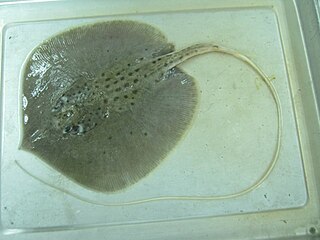
The white-edge freshwater whipray is an extremely rare species of stingray in the family Dasyatidae, native to four river systems in Southeast Asia. Measuring up to 60 cm (24 in) across, this ray has an oval pectoral fin disc and a very long, whip-like tail without fin folds. It can be identified by the presence of a sharply delineated white band running around the margin of its otherwise brown disc, as well as by its white tail and a band of dermal denticles along the middle of its back. This species feeds on benthic invertebrates and is aplacental viviparous. Its two long tail spines are potentially dangerous to humans. The International Union for Conservation of Nature (IUCN) has assessed the white-edge freshwater whipray as Endangered, as it is under heavy pressure from fishing and habitat loss, degradation, and fragmentation.

The cowtail stingray is a species of stingray in the family Dasyatidae, widespread in the Indo-Pacific region and occasionally entering freshwater habitats. Other common names include banana-tail ray, drab stingray, fantail ray, feathertail stingray, and frill tailed sting ray. This species is sometimes placed in the genus Dasyatis or Hypolophus. The most distinctive characteristic of the cowtail stingray is the large, flag-like ventral fold on its tail, which is especially prominent when the ray is swimming. This species is targeted by commercial fisheries as a source of high-quality shagreen, a type of leather, and its populations are now under threat from heavy exploitation.

The mangrove whipray or whitetail stingray, is a species of stingray in the family Dasyatidae. It is widely distributed in the Indo-Pacific region from the Red Sea to northern Australia and Micronesia. A benthic inhabitant of shallow inshore waters, juvenile mangrove whiprays favor mangrove and estuarine habitats, while adults favor sandy to rocky areas in lagoons and coral reefs. This species can be identified by its thick, oval pectoral fin disc that is dark gray above with numerous white flecks, and by its relatively short, whip-like tail that is white past the stinging spine. It grows up to 1.4 m (4.6 ft) across.

The reticulate whipray or honeycomb stingray is a species of stingray in the family Dasyatidae. It inhabits coastal waters in the western Indian Ocean including the Red Sea, Natal and the Arabian Sea; also a Lessepsian transmigrant in the eastern Mediterranean. A large species reaching 2 m (6.6 ft) in width, the reticulate whipray has a diamond-shaped pectoral fin disc and an extremely long tail without fin folds. Both its common and scientific names refer to its ornate dorsal color pattern of many small, close-set dark spots or reticulations on a lighter background. However, the reticulate whipray is only one of several large spotted stingrays in the Indo-Pacific which, coupled with the variability of its coloration with age and locality, has resulted in a great deal of taxonomic confusion.

The Jenkins' whipray is a species of stingray in the family Dasyatidae, with a wide distribution in the Indo-Pacific region from South Africa to the Malay Archipelago to northern Australia. This large species grows to 1.5 m (4.9 ft) across and has a broad, diamond-shaped pectoral fin disc and a whip-like tail without fin folds. It has a band of heart-shaped dermal denticles running from between the eyes to the tail on its upper surface, along with a characteristic row of large spear-like thorns along the midline. It is uniform yellowish brown above, becoming grayish on the tail past the stinging spine, and white below; there is apparently a spotted color variant that had previously been described as a different species, the dragon stingray.
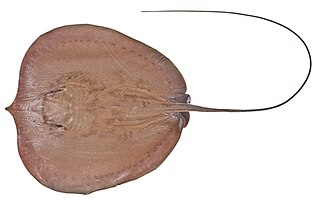
The freshwater whipray is a little-known species of stingray in the family Dasyatidae, found in a number of large rivers and associated estuaries in northern Australia. Until recently, this species was regarded as a regional subpopulation of the similar-looking but much larger giant freshwater stingray of Southeast Asia. Typically reaching 1 m (3.3 ft) across, the freshwater whipray has a distinctively shaped, rounded pectoral fin disc, a projecting snout, and a thin tail without fin folds. It is plain brown above and white below with dark marginal bands. It may occasionally travel onto land and can "breathe" out of water for up to 7 minutes. The freshwater whipray is an active hunter of small fishes and shrimps, and does not currently face substantial conservation threats.

The pearl stingray is a little-known species of stingray in the family Dasyatidae, found in shallow coastal waters from Mauritania to Angola, though fossils have been found in Portugal. Growing to 30 cm (12 in) across, this species has a rounded pectoral fin disc with a pointed snout, and a wide band of dermal denticles over the back in adults. It closely resembles and is often confused for the much larger daisy stingray ; both species are characterized by the presence of an enlarged, nacreous denticle in the middle of the back called a "pearl spine". The International Union for Conservation of Nature (IUCN) assesses the pearl stingray's conservation status as Near Threatened, but it is likely that most of the historically reported fishery catches of the daisy stingray were in fact of this species.
The roughnose stingray is a little-known species of stingray in the family Dasyatidae, generally found in shallow, estuarine waters associated with mangroves off Borneo, Sumatra, and possibly Java. Growing to 72 cm (28 in) across, this species has a rhomboid pectoral fin disc and a whip-like tail with a ventral fin fold. It is characterized by its pointed snout, which is covered by dermal denticles. Reproduction is aplacental viviparous, with females possibly bearing as few as one pup at a time. The International Union for Conservation of Nature (IUCN) has assessed the roughnose stingray as Endangered; it is threatened by overfishing and the destruction and degradation of its mangrove habitat.
The Hortle's whipray is a little-known species of stingray in the family Dasyatidae, occurring in shallow estuaries and mud flats off southern New Guinea. This species, growing to 71 cm (28 in) across, has a heart-shaped pectoral fin disc with a long, pointed snout and minute eyes. It has a wide dorsal band of dermal denticles extending from in front of the eyes to the tail, as well as scattered sharp denticles on the snout. The underside of the disc is a distinctive bright yellow in color, sometimes with darker markings around the nostrils, mouth, and gill slits. The Hortle's whipray is threatened by extensive seine fisheries and habitat degradation, leading the International Union for Conservation of Nature (IUCN) to assess it as Near Threatened.

The black-spotted whipray is a species of stingray in the family Dasyatidae, found in the coastal waters off southern New Guinea and northern Australia. Long thought to be a variant of the related brown whipray, this species has an angular, diamond-shaped pectoral fin disc and a whip-like tail without fin folds. It is characterized by its dorsal color pattern, which consists of a variably extensive covering of small, close-set dark, and sometimes also white spots, on a grayish-brown background. In addition, the tail has alternating light and dark saddles past the stinging spine. This species reaches a maximum recorded width of 80 cm (31 in).
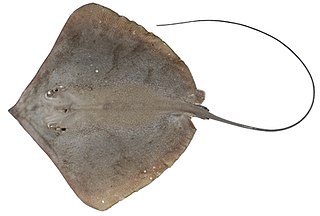
The brown whipray is a species of stingray in the family Dasyatidae, common in inshore, muddy habitats along the northern coast of Australia. It has often been confused in literature for the honeycomb stingray and the black-spotted whipray, which until recently was thought to be the same species. This species has an angular, diamond-shaped pectoral fin disc and a long, very thin tail without fin folds. It is plain brown above, sometimes with white dots or flecks near the edge of the disc, and white below; the tail is dark all over, with alternating dark and light bands near the tip. The maximum recorded disc width is 74 cm (29 in).

The leopard whipray is a little-known species of stingray in the family Dasyatidae, found in the Indian and Pacific Oceans from the Andaman Sea to the Coral Triangle. It is found close to shore at depths shallower than 70 m (230 ft), over soft substrates. Attaining a width of 1.8 m (5.9 ft), this species has a diamond-shaped pectoral fin disc with a pointed snout and an extremely long, whip-like tail without fin folds. Adult rays have a leopard-like dorsal pattern of dark brown rings on a yellowish brown background, as well as a row of enlarged, heart-shaped dermal denticles along the midline of the disc. Newborns and small juveniles have large, solid dark spots and few denticles. The leopard whipray is caught by fisheries in many parts of its range, primarily for meat.

The honeycomb whipray is a species of stingray in the family Dasyatidae, found widely in the shallow coastal waters of the Indo-Pacific from India to the Malay Archipelago. This large species grows to 1.3 m (4.3 ft) across and has a diamond-shaped disc with rounded corners and a projecting, pointed snout. Its tail is long and whip-like, without fin folds. Adults have a striking dorsal color pattern consisting of large, dark brown rings and reticulations delineated by thin yellow lines, while juveniles have a pattern of large dark spots. This ray can also be distinguished from its similar relatives by an enlarged, pearl-like dermal denticle at the center of the back, which is followed by a few thorns. The International Union for Conservation of Nature (IUCN) has assessed the honeycomb whipray as endangered, as it faces heavy fishing pressure and habitat degradation across much of its range.


















